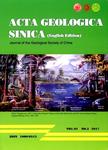Dating of the Dachang Superlarge Tin-polymetallic Deposit in Guangxi and Its Implication for the Genesis of the No. 100 Orebody
Dating of the Dachang Superlarge Tin-polymetallic Deposit in Guangxi and Its Implication for the Genesis of the No. 100 Orebody作者机构:InstituteofMineralResourcesChineseAcademyofGeologicalSciencesBeijing100037 ChineseAcademyofGeologicalSciencesBeijing100037 InstituteofGeologyChineseAcademyofGeologicalSciencesBeijing100037 InstituteofGeologyandGeophysicsChineseAcademyofSciencesBeijing100010 YichangInstituteofGeologyandMineralResourcesYichangHubei443003 GuangxiBureauofGeologyandMineralResourcesNanningGuangxi530023
出 版 物:《Acta Geologica Sinica(English Edition)》 (地质学报(英文版))
年 卷 期:2004年第78卷第2期
页 面:452-458页
核心收录:
学科分类:0709[理学-地质学] 081803[工学-地质工程] 070901[理学-矿物学、岩石学、矿床学] 07[理学] 08[工学] 0708[理学-地球物理学] 0818[工学-地质资源与地质工程]
基 金:the State Key BasicResearch Program ofChina(TG1999043203 ,TG1999043201) the Geological Survey Program(K1.4-3-4)under the Ministry of Land and Resources
主 题:superlarge Sn-polymetal deposit Guangxi Dachang geochronology pressure release and evaporation
摘 要:The Dachang superlarge Sn-polymetal deposit in Guangxi, China, is one of the largest tin deposit all over the world. However, this deposit has long been in debate as to its origin. One of the opinions is that the Dachang deposit was formed by replacement of hydrothermal solution originating from Yanshanian granites, and the other is that this deposit was formed by submarine exhalation in the Devonian. This paper presents some new isotopic geochronology data obtained with the 40Ar-39Ar method for quartz and sanidine from massive ore in the No. 91 and No. 100 orebodies. Analytic results show that the No. 91 orebody was formed at 94.52±0.33 Ma (the plateau age obtained with the 40Ar-39Ar method for quartz) or 91.4±2.9 Ma (the plateau age obtained with the 40Ar-39Ar method for feldspar), while the No. 100 orebody was formed at 94.56±0.45 Ma (the plateau age obtained with the 40Ar-39Ar method for quartz), suggesting that both the No. 91 and the No. 100 orebodies were formed at the Late Yanshanian instead of the Devonian. The No. 100 orebody might be formed by filling of ore materials into caves in Devonian reef limestone. Because the ore-bearing solution released its pressure and lowered its temperature suddenly in a cave environment, ore minerals were formed concentratedly while water and other materials such as CO2 evaporated quickly, resulting less alteration of host rocks.



